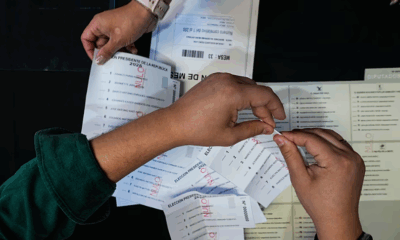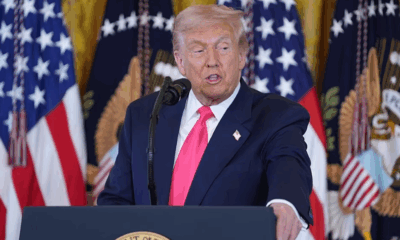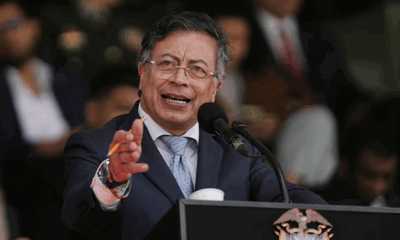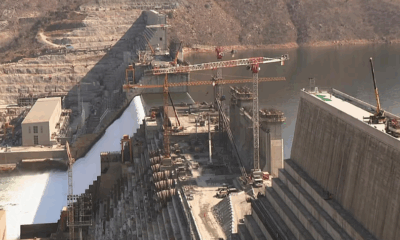News
U.S. Businesses Brace for Impact as Trump’s Tariffs Take Effect
American businesses across multiple industries are preparing for financial strain as former President Donald Trump’s newly imposed tariffs on imports from Canada, Mexico, and China take effect. The levies, which include a 25% tax on Canadian and Mexican goods and a 10% tax on Chinese imports, are set to be implemented on Tuesday, with Canadian energy products facing a lower 10% rate.
According to estimates from the Budget Lab at Yale University, these tariffs could cost the average American household between $1,000 and $1,200 in annual purchasing power. Economists also warn of broader economic consequences, with inflation projected to rise by 0.4 percentage points this year and U.S. economic growth expected to slow from 2.8% in 2023 to a decline of 1.5% in 2025 and 2.1% in 2026.
Small Businesses Face Rising Costs
For businesses like The Penny Ice Creamery in Santa Cruz, California, the tariffs could mean higher costs for essential equipment imported from China, including refrigerators, freezers, and blenders. Co-owner Zach Davis fears that rising expenses will force him to raise prices yet again. Even small items like sprinkles—imported from Ontario—will be affected by a 25% tax, potentially cutting into the shop’s already thin profit margins.
In North Carolina, Casey Hite, CEO of Aeroflow Health, a medical supply company, worries that the increased cost of Chinese-manufactured breast pumps and other supplies will ultimately lead to higher health insurance premiums for American consumers. With insurance reimbursement rates locked in before the tariffs, Aeroflow may be forced to either accept financial losses or switch to lower-quality products.
Similarly, Linda Schlesinger-Wagner, owner of Skinnytees, a Michigan-based women’s apparel brand, expects higher costs due to the 10% tax on Chinese imports. Although she plans to absorb the expense rather than pass it on to customers, she predicts that consumers will soon see price hikes across the board on everything from clothing to food and cars.
Supply Chain Disruptions and Inflation Concerns
While some industries have stocked up on goods in anticipation of the tariffs, experts warn that the economic impact will be felt within months. Construction companies, for example, have been hoarding materials, but once their inventories dwindle, the price of materials will likely spike, causing project delays and increased costs.
Supermarkets and produce vendors, however, have no ability to stockpile perishable goods. In Nogales, Arizona, tomato distributor Rod Sbragia fears that the import taxes will lead to fewer choices for consumers and higher prices on fresh fruits and vegetables.
Even American farmers could face economic consequences, as Canada, Mexico, and China may impose retaliatory tariffs on U.S. agricultural products. In Trump’s first term, China responded to tariffs by targeting American soybeans and pork, prompting the administration to spend billions in taxpayer money to compensate farmers for lost sales.
As the new tariffs take effect, many in rural America are counting on similar relief measures. “The Trump administration provided a safety net,” said Lee Wicker of the North Carolina Growers Association. “Farmers trust that he’s going to take care of anybody who’s hurt by the tariffs.”
With economic uncertainty looming, business owners and consumers alike are bracing for the financial fallout of Trump’s latest trade measures.
News
Chile Holds Presidential Election Amid Crime and Immigration Debate
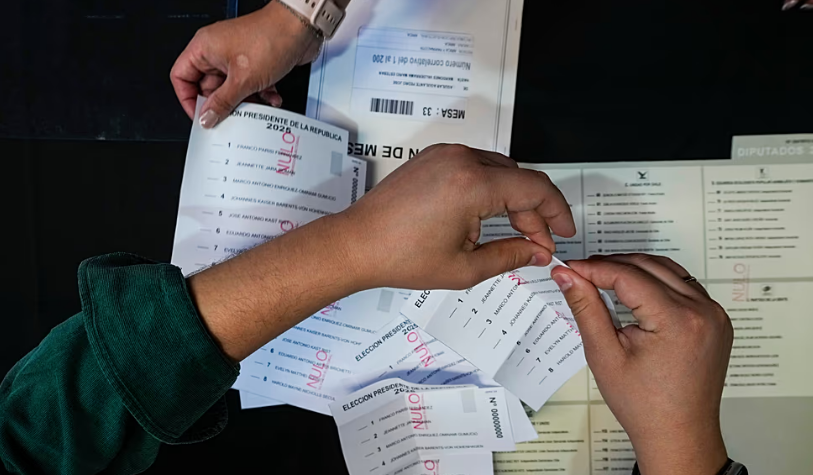
Chile is holding its presidential election on Sunday, with candidates campaigning on tough stances on crime and immigration. The vote comes four years after progressive Gabriel Boric was elected, at a time when the electorate is deeply divided and a new compulsory voting law adds an element of uncertainty.
Over 14 million Chileans are eligible to vote in the elections, which will also renew the entire Chamber of Deputies and nearly half of the Senate. Security and immigration concerns have dominated the campaign, shifting public attention toward conservative candidates. Evelyn Matthei has called for drug traffickers to be “in jail or in the cemetery,” while Franco Parisi described drug trafficking as “narco-terrorism” and advocated for “bullet or jail.”
The three main contenders offer contrasting visions for Chile’s future. José Antonio Kast, 59, a Republican Party member and the brother of a former minister who served under General Augusto Pinochet, is running for president for the third time. He has focused his campaign on combating crime and illegal immigration. Jeannette Jara, 51, a former minister in Boric’s government and member of the Communist Party, has pledged to expand pensions, lower electricity costs, and construct tens of thousands of new homes. Johannes Kaiser, 49, a former YouTube commentator and legislator, has questioned vaccination programs, opposed abortion, and promised to withdraw Chile from climate agreements and the Inter-American Court of Human Rights.
The introduction of compulsory voting in 2023 could significantly affect turnout, particularly among younger voters. Generation Z, born after 1996, accounts for roughly a third of the electorate, and polls suggest that 30% of these voters have yet to decide. Social media has played a major role, with candidates using platforms like TikTok to mobilize supporters. Jara and Matthei have accused Kast of orchestrating social media campaigns against them, allegations he denies.
Polls indicate a close race. Latest surveys show Jara leading with 30% support, followed by Kast at 22% and Kaiser at 15%. Prediction markets, however, see Kast as the frontrunner with a 70% chance of winning. Analysts suggest that none of the candidates is likely to secure an absolute majority on Sunday, making a run-off election probable on 14 December, likely between Jara and Kast.
A conservative or far-right advance could also reshape the legislative landscape. Polls suggest that both coalitions might achieve a majority in Congress, raising the possibility of a government with limited parliamentary opposition—a scenario not seen in Chile in the past 15 years.
Polling stations opened at 8:00 local time (UTC-4) and will close at 18:00. With crime, immigration, and economic issues at the forefront, this election is being closely watched as a test of Chile’s political direction in a highly polarized environment.
News
Trump Orders Justice Department Probe Into Epstein Ties With Clinton, Other Democrats

Former US President Donald Trump has directed Attorney General Pam Bondi to launch an investigation into connections between convicted sex offender Jeffrey Epstein and several prominent Democrats, including former President Bill Clinton. The move follows the release of new emails by Congress showing Epstein’s communications with influential figures in the US and abroad.
The emails, released Wednesday by the House Oversight Committee, stem from Epstein’s personal accounts and reveal interactions with lawmakers, business leaders, and other high-profile individuals. Trump accused the Democratic Party of attempting to revive what he called the “Epstein hoax” to distract from policy failures and political setbacks, including a recent government shutdown.
“Epstein was a Democrat, and he is the Democrat’s problem, not the Republican’s problem,” Trump said in a statement on social media. He also referenced Clinton, former Treasury Secretary Larry Summers, and LinkedIn founder and major Democratic donor Reid Hoffman, asserting that they had close ties to Epstein.
Trump confirmed that he had instructed Bondi to investigate Epstein’s connections with Clinton, Summers, Hoffman, and financial institutions such as J.P. Morgan Chase. “I will be asking A.G. Pam Bondi, and the Department of Justice, together with our great patriots at the FBI, to investigate Jeffrey Epstein’s involvement and relationship with Bill Clinton, Larry Summers, Reid Hoffman, J.P. Morgan, Chase, and many other people and institutions, to determine what was going on with them, and him,” Trump said.
Clinton has denied any wrongdoing or awareness of Epstein’s criminal activities. J.P. Morgan Chase also issued a statement expressing regret over any association with Epstein, emphasizing that it had ended relations with him years before his arrest. “We regret any association we had with the man, but did not help him commit his heinous acts,” said Patricia Wexler, a spokesperson for the bank.
Bondi announced via social media that she had appointed Jay Clayton, U.S. Attorney for the Southern District of New York, to oversee the investigation. “Clayton is one of the most capable and trusted prosecutors in the country, and I’ve asked him to take the lead,” she said, noting that the Department of Justice would conduct the inquiry with “urgency and integrity.”
The announcement comes a week before the House of Representatives is set to vote on whether the Justice Department should release all files related to Epstein, who died by suicide in a federal prison in 2019 while awaiting trial on sex-trafficking charges. Republican Congresswoman Marjorie Taylor Greene urged Trump to ensure that House Republicans vote in favor of releasing the documents, calling failure to do so a “huge miscalculation.” Greene and four other House Republicans have already filed a discharge petition, which has garnered 218 signatures, seeking the public release of all Epstein-related records.
The investigation highlights ongoing scrutiny of Epstein’s network and connections to prominent political and financial figures, as well as continuing debates over transparency and accountability in Washington.
News
US Nuclear Weapons in Germany Raise Security Questions Amid Rising Global Tensions
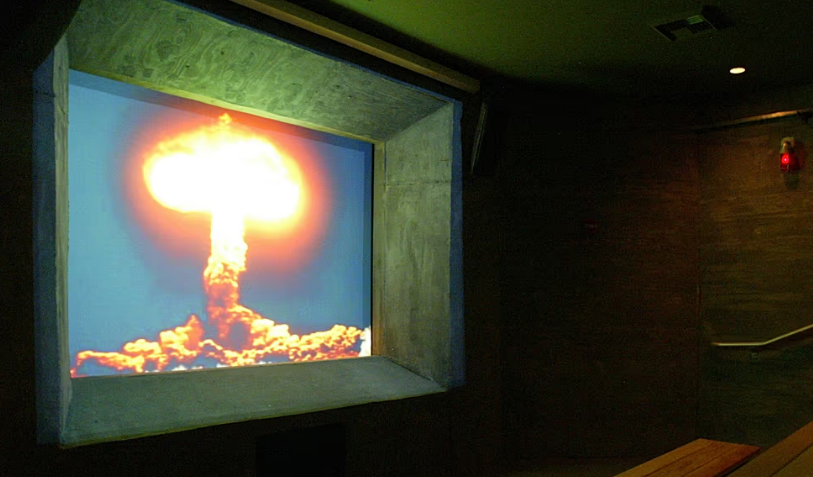
As the Bundeswehr marks its 70th anniversary in Berlin, the celebration is shadowed by growing anxiety over Germany’s security. Around 20 US nuclear weapons are currently stored in the country—modernised, ready for use, and symbolic of Washington’s longstanding commitment to Europe’s defence. Yet experts warn that this deterrent may not guarantee protection if the United States hesitates to act in a crisis.
The weapons, believed to be B61-12 hydrogen bombs stored at Büchel Air Base in Rhineland-Palatinate, can be deployed by fighter jets such as the Eurofighter. Their destructive capacity remains immense. The bombs form part of the US nuclear umbrella extended to NATO allies since the Cold War, but concerns have deepened over the reliability of that shield under President Donald Trump, who has questioned aspects of NATO’s mutual defence commitments.
“It has never been and cannot be certain that the US will actually deploy nuclear weapons. It is not a guarantee. But the important thing is that the enemy cannot rule it out,” said political scientist and security expert Karl-Heinz Kamp, a former president of the Federal Academy for Security Policy and an associate fellow at the German Council on Foreign Relations. “Deterrence is pure speculation. It has held up so far, for 50 years.”
Reports from several US media outlets suggest that the United States brought new nuclear weapons to Europe over the summer, with signs including flight paths and the delivery of F-35 fighter jets designed to carry tactical nuclear weapons. Germany has also ordered a fleet of F-35s, expected to arrive in 2026.
Since the invasion of Ukraine in 2022, nuclear deterrence has returned to the forefront of European security debates. Russian President Vladimir Putin has repeatedly brandished nuclear threats, touting his arsenal of about 5,500 warheads and showcasing intercontinental missiles such as the RS-24 “Yars.” Kamp noted that while Putin uses nuclear rhetoric as a political tool, actual deployment remains unlikely. “Whoever shoots first, dies second. That is not a desirable state of affairs,” he said.
Still, questions persist about whether US nuclear weapons in Germany could be relocated to NATO’s eastern flank, including the Baltic states, Poland, or Romania, as a stronger warning to Moscow. Kamp acknowledged this possibility, calling such a move a potential “signal to Russia.”
Anti-nuclear groups, including ICAN Germany, continue to demand the withdrawal of US weapons from German territory, arguing that they make the country a target rather than a protectorate.
While some analysts argue that Germany could technically produce its own nuclear arsenal, Kamp described the idea as politically untenable given Germany’s post-war commitments. The nation is bound by the 1990 Two Plus Four Treaty and the 1969 Nuclear Non-Proliferation Treaty, both of which prohibit it from developing nuclear weapons.
Public opinion also stands firmly against the idea. Only about a third of Germans support developing domestic nuclear arms. For now, Germany’s security remains anchored within NATO, protected not only by the United States but also by the nuclear capabilities of France and the United Kingdom.
-

 Entertainment1 year ago
Entertainment1 year agoMeta Acquires Tilda Swinton VR Doc ‘Impulse: Playing With Reality’
-

 Business1 year ago
Business1 year agoSaudi Arabia’s Model for Sustainable Aviation Practices
-

 Business1 year ago
Business1 year agoRecent Developments in Small Business Taxes
-

 Home Improvement12 months ago
Home Improvement12 months agoEffective Drain Cleaning: A Key to a Healthy Plumbing System
-

 Politics1 year ago
Politics1 year agoWho was Ebrahim Raisi and his status in Iranian Politics?
-

 Business1 year ago
Business1 year agoCarrectly: Revolutionizing Car Care in Chicago
-

 Business1 year ago
Business1 year agoSaudi Arabia: Foreign Direct Investment Rises by 5.6% in Q1
-

 Sports1 year ago
Sports1 year agoKeely Hodgkinson Wins Britain’s First Athletics Gold at Paris Olympics in 800m

